Aristotle was the earliest to attempt a more scientific basis for classification. He used simple morphological characters to classify plants into trees, shrubs and herbs. He also divided animals into two groups, those which had red blood and those that did not.
Linnaeus' gave two kingdom system
i - Plantae kingdom ii - Animalia kingdom
included all plants and animals respectively
This system did not distinguish between
- The eukaryotes and prokaryotes
- Unicellular and multicellular organisms
- Photosynthetic (green algae) and non-photosynthetic (fungi) organisms.
R.H. Whittaker (1969) : - Proposed a Five Kingdom Classification
1- Monera 2- Protista 3- Fungi
4- Plantae 5- Animalia.

The main criteria for classification used by him
- cell structure
- body organization
- mode of nutrition
- reproduction and phylogenetic relationships.
- Six Kingdom- Monera kingdom divided into Archaea and Eubacteria.
- All other Kingdom Protista, Fungi, Plantae and Animalia are Eukaryotes.
Earlier classification systems
- Included bacteria, blue green algae, fungi, mosses, ferns, gymnosperms and the angiosperms under ‘Plants’
- The character that unified this whole kingdom was that all the organisms included had a cell wall in their cells.
- It brought together the prokaryotic bacteria and the blue green algae (cyanobacteria) with other groups which were eukaryotic.
- The classification did not differentiate between the heterotrophic group – fungi, and the autotrophic green plants
Solve the problems of Earliest classification system
- Cell wall composition separates kingdom Fungi (Chitin cell wall) and Plantae (cellulosic cell wall).
- All prokaryotic organisms were grouped together under Kingdom Monera.
- unicellular eukaryotic organisms were placed in Kingdom Protista.
- Cell wall is absent in kingdom Animalia.
- Kingdom Protista has brought together Chlamydomonas, Chlorella (earlier placed in Algae within Plants and both having cell walls) with Paramecium and Amoeba (which were earlier placed in the animal kingdom which lack cell wall).
Kingdom Monera
- Unicellular, Prokaryotes
- Bacteria are the sole members of the Kingdom Monera.
- live in extreme habitats such as hot springs, deserts, snow and deep oceans where very few other life forms can survive.
- Many of them live in or on other organisms as parasites.
- Bacteria are grouped under four categories based on their shape
(i) spherical Coccus (pl.: cocci) (ii) rod-shaped Bacillus (pl.: bacilli)
(iii) comma-shaped Vibrium (pl.: vibrio) (iv) spiral Spirillum (pl.: spirilla)

- bacterial structure is very simple, they are very complex in behaviour.
- bacteria as a group show the most extensive metabolic diversity.
- Some of the bacteria are autotrophic, i.e., they synthesise their own food from inorganic substrates.
- They may be photosynthetic autotrophic or chemosynthetic autotrophic.
- majority of bacteria are heterotrophs, i.e., they depend on other organisms or on dead organic matter for food.
It is divided into three types :
(i) Archaebacteria (ii) Eubacteria (iii) Mycoplasma
(i) Archaebacteria
- These bacteria are special since they live in some of the most harsh habitats such as
- extreme salty areas (halophiles). (NEET 2017)
- hot springs (thermoacidophiles).
- marshy areas (methanogens). (NEET 2016)
- Deep ocean where no sun light present. (NEET 2013)
. Archaebacteria differ from other bacteria in having a different cell wall structure and this feature is responsible for their survival in extreme conditions
Methanogens are present in the gut of several ruminant animals such as cows and buffaloes and they are responsible for the production of methane (biogas) from the dung of these animals. (NEET 2016)
(ii) Eubacteria
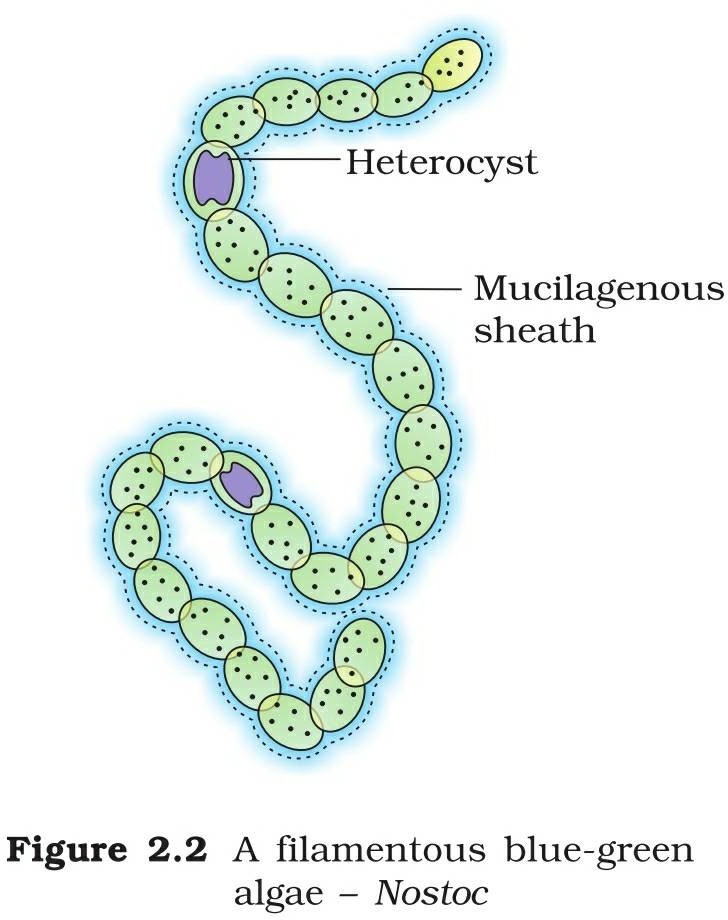
- also known as ' True Bacteria '. (NEET 2016)
- presence of a rigid cell wall, and if motile, a flagellum.
- The cyanobacteria (also referred to as blue-green algae) have chlorophyll a similar to green plants and are photosynthetic autotrophs. (NEET 2012)
- Cyanobacteria are unicellular, colonial or filamentous, freshwater/marine or terrestrial algae.
- The colonies are generally surrounded by gelatinous sheath.
- Some can fix atmospheric nitrogen in specialised cells called heterocysts, e.g., Nostoc and Anabaena. (NEET 2012)
- Chemosynthetic autotrophic bacteria oxidise various inorganic substances such as nitrates, nitrites and ammonia and use the released energy for their ATP production.
- They play a great role in recycling nutrients like nitrogen, phosphorous, iron and sulphur.
- Heterotrophic bacteria are most abundant in nature.
- Mostly important decomposers.
- helpful in making curd from milk, production of antibiotics, fixing nitrogen in legume roots.
- Some are Pathogens
- Cholera, typhoid, tetanus, citrus canker are well known diseases caused by different bacteria. (NEET 2016)
(iii) Mycoplasma
- The Mycoplasma are organisms that completely lack a cell wall. (NEET 2015,2017)
- They are the smallest living cells known and can survive without oxygen.
- Many mycoplasma are pathogenic in animals and plant
- Reproduction:
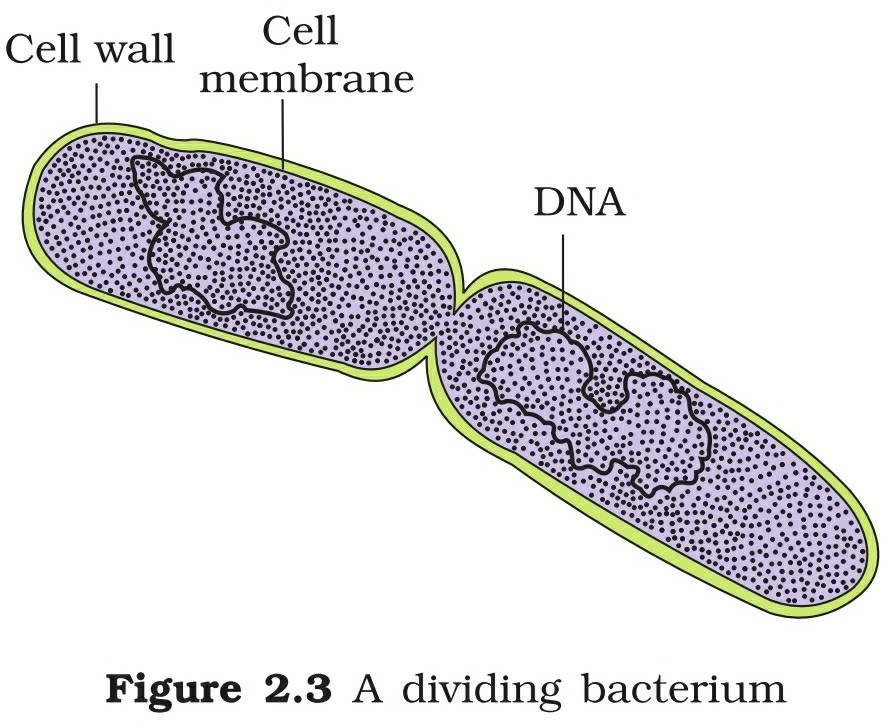
- Bacteria reproduce mainly by fission.
- Sometimes, under unfavourable conditions, they produce spores.
- They also reproduce by a sort of sexual reproduction by adopting a primitive type of DNA transfer from one bacterium to the other.
Kingdom Protista
- All single-celled eukaryotes. (NEET 2010,2016).
- boundaries of this kingdom are not well defined.
- Protista are primarily aquatic.
- This kingdom forms a link with the others dealing with plants, animals and fungi.
- Some have flagella or cilia.
- Protists reproduce asexually and sexually by a process involving cell fusion and zygote formation.
• It includes
- (I) Chrysophytes (ii) Dinoflagellates (iii) Euglenoids (iv)Slime moulds (v) Protozoans (NEET 2017)
(I) Chrysophytes
- includes diatoms and golden algae (desmids). (NEET 2016)
- found in fresh water as well as in marine environments.
- microscopic and float passively in water currents (plankton). (NEET 2017)
- Most of them are photosynthetic.
- In diatoms the cell walls form two thin overlapping shells, which fit together as in a soap box. (NEET 2015)
- The walls are embedded with silica and thus the walls are indestructible. (NEET 2017)
- diatoms have left behind large amount of cell wall deposits in their habitat; this accumulation over billions of years is referred to as ‘diatomaceous earth’.
- Being gritty this soil is used in polishing, filtration of oils and syrups.
- Diatoms are the chief ‘producers’ in the oceans. (NEET 2018)
(ii) Dinoflagellates

mostly marine and photosynthetic.
appear yellow, green, brown, blue or red depending on the main pigments present in their cells.
- cell wall has stiff cellulose plates on the outer surface.
- Most of them have two flagella; one lies longitudinally and the other transversely in a furrow between the wall plates.
- red dinoflagellates (Example: Gonyaulax) undergo such rapid multiplication that they make the sea appear red (red tides). (NEET 2008)
- Toxins released by such large numbers may even kill other marine animals such as fishes.
(iii) Euglenoids
- Mostly fresh water organisms found in stagnant water.
- a protein rich layer called pellicle which makes their body flexible (cell wall is absent)
- They have two flagella, a short and a long one.
- photosynthetic in the presence of sunlight, when deprived of sunlight they behave like heterotrophs by predating on other smaller organisms. (NEET 2015)
- the pigments of euglenoids are identical to those present in higher plants.
- Example: Euglena
(iv)Slime moulds
- Slime moulds are saprophytic protists.
- body moves along decaying twigs and leaves engulfing organic material.
- In favourable conditions, they form an aggregation called plasmodium which may grow and spread over several feet.
- In unfavourable conditions, the plasmodium differentiates and forms fruiting bodies bearing spores at their tips.
- The spores possess true walls. They are extremely resistant and survive for many years, even under adverse conditions.
- spores are dispersed by air currents.
(v) Protozoans
- All protozoans are heterotrophs and live as predators or parasites.
- They are believed to be primitive relatives of animals.
- four major groups of protozoans are :-
(a) Amoeboid (b) Flagellated (c) Ciliated (d) Sporozoans
(a)Amoeboid Protozoans
- live in fresh water, sea water or moist soil.
- They move and capture their prey by putting out pseudopodia (false feet). (NEET 2018)
- Marine forms have silica shells on their surface.
Entamoeba are parasites
• (b) Flagellated protozoans:
- They have flagella.
- free-living or parasitic.
- The parasitic forms cause diseases such as sleeping sickness. Example: Trypanosoma. (Aipmt 2006)
• (c) Ciliated protozoans:
- aquatic, actively moving organisms because of the presence of thousands of cilia.
- They have a cavity (gullet) that opens to the outside of the cell surface.
- coordinated movement of rows of cilia causes the water laden with food to be steered into the gullet.
- These are differ from all other Protozoans on the basis of two nuclei .
- Macronuclei control metabolism and Micronuclei participate in Reproduction. (NEET 2018)
Example: Paramecium
• (d) Sporozoans:
- have an infectious spore-like stage in their life cycle.
The most notorious is Plasmodium (malarial parasite) which causes malaria
Kingdom Fungi
- kingdom of heterotrophic organisms.
- White spots seen on mustard leaves are due to a parasitic fungus.
- unicellular fungi, e.g., yeast are used to make bread and beer.
- Some fungi cause diseases in plants and animals ( ex. wheat rust-causing Puccinia)
- Some are the source of antibiotics, e.g., Penicillium.
- occur in air, water, soil and on animals and plants.
- prefer to grow in warm and humid places.
- with Exception of Yeast (unicellular) fungi are filamentous. Their bodies consist of long, slender thread-like structures called hyphae. The network of hyphae is known as mycelium. (NEET 2019)
- Some hyphae are continuous tubes filled with multinucleated cytoplasm – these are called coenocytic hyphae.
- Others have septae or cross walls in their hyphae.
- cell walls of fungi are composed of chitin and polysaccharides. (NEET 2016)
- Mostly absorb soluble organic matter from dead substrates and hence are called saprophytes.
- Some that depend on living plants and animals are called parasites.
- live as symbionts – in association with algae as lichens
- with roots of higher plants as mycorrhiza. (NEET 2019)
▪ Reproduction in Fungi
- Vegetative- by Fragmentation, Fission and Budding
- Asexual - by spores called conidia or sporangiospores or zoospores.
- Sexual - by oospores , ascospores and basidiospores .
- various spores are produced in distinct structures called fruiting bodies.
• sexual cycle involves the following three steps:
- Fusion of protoplasms between two motile or non-motile gametes called plasmogamy.
- Fusion of two nuclei called karyogamy.
- Meiosis in zygote resulting in haploid spores.
- two haploid hyphae of compatible mating types come together and fuse.
- In some fungi the fusion of two haploid cells immediately results in diploid cells (2n).
- in other fungi (ascomycetes and basidiomycetes), an intervening dikaryotic stage (n + n, i.e., two nuclei per cell) occurs; such a condition is called a dikaryon and the phase is called dikaryophase of fungus.
- reduction division occurs in fruiting bodies leading to formation of haploid spores.
- Various Class of Fungi are:
1. Phycomycetes 2. Ascomycetes 3. Basidiomycetes 4.Deuteromycetes
1.Phycomycetes
- found in aquatic habitats and on decaying wood in moist and damp places or as obligate parasites on plants.
- The mycelium is aseptate and coenocytic.
- Asexual reproduction by zoospores (motile) or by aplanospores (non- motile).(endogenously produced in sporangium
- A zygospore is formed by fusion of two gametes (similar in morphology (isogamous) or dissimilar (anisogamous or oogamous).
- ex. Mucor,
- Rhizopus (the bread mould mentioned earlier)
- Albugo (the parasitic fungi on mustard).
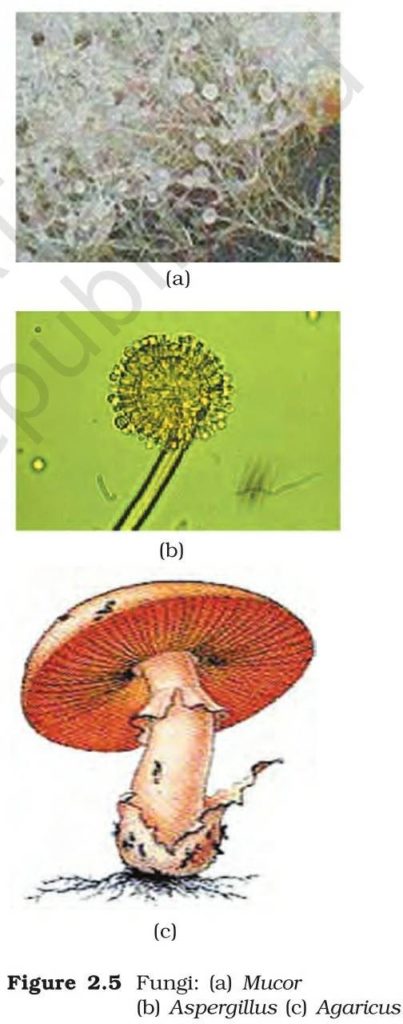
2. Ascomycetes
- Commonly known as sac-fungi (mostly multicellular, e.g., Penicillium, or rarely unicellular, e.g., yeast)
- They are saprophytic, decomposers, parasitic or coprophilous (growing on dung).
- Mycelium is branched and septate.
- Asexual spores are conidia produced exogenously on the special mycelium called conidiophores. Conidia on germination produce mycelium.
- Sexual spores are called ascospores which are produced endogenously in sac like asci (singular ascus). These asci are arranged in different types of fruiting bodies called ascocarps.
- Ex. Aspergillus, Claviceps and Neurospora.
- Neurospora is used extensively in biochemical and genetic work.
- Members like morels and truffles are edible and are considered delicacies. (NEET 2015)
3. Basidiomycetes
- Commonly known form are mushrooms, bracket fungi or puffballs.
- grow in soil, on logs and tree stumps and in living plant bodies as parasites, e.g., rusts and smuts.
- The mycelium is branched and septate.
- Asexual spores are generally not found, but vegetative reproduction by fragmentation is common.
- Sex organs are absent, but plasmogamy is brought about by fusion of two vegetative or somatic cells of different strains or genotypes produce dikaryotic which ultimately gives rise to basidium.
- Karyogamy and meiosis take place in the basidium producing four basidiospores.
- The basidiospores are exogenously produced on the basidium (pl.: basidia).
- The basidia are arranged in fruiting bodies called basidiocarps.
- Ex. Agaricus (mushroom), Ustilago (smut) and Puccinia (rust fungus). (NEET 2018)
4. Deuteromycetes
- known as imperfect fungi because only the asexual or vegetative phases of these fungi are known.
- When sexual forms of these fungi were discovered they were moved into classes they rightly belong to.
- If asexual and vegetative stage have been given one name (and placed under deuteromycetes)
- If perfect (sexual) stages of members of dueteromycetes were discovered they were often moved to ascomycetes and basidiomycetes.
- These reproduce only by asexual spores known as conidia.
- The mycelium is septate and branched.
- Some are saprophytes or parasites while mostly are decomposers of litter and help in mineral cycling.
- Ex. Alternaria, Colletotrichum and Trichoderma. (NEET 2015)
VIRUSES, VIROIDS, PRIONS AND LICHENS
• Virus
- In the five kingdom classification of Whittaker there is no mention of lichens and some acellular organisms like viruses, viroids and prions. These are briefly introduced here.
- The viruses are non-cellular organisms that are characterised by having an inert
crystalline structure outside the living cell.
- Once they infect a cell they take over the machinery of the host cell to replicate themselves, killing the host.
- Name virus that means venom or poisonous fluid was given by Dmitri Ivanowsky (1892)
- These smaller than bacteria because they passed through bacteria-proof filters.
- M.W. Beijerinek (1898) demonstrated that the extract of the infected plants of tobacco could cause infection in healthy plants and called the fluid as Contagium vivum fluidum (infectious living fluid).
- W.M. Stanley (1935) showed that viruses could be crystallised and crystals consist largely of proteins. (NEET 2015)
- They are inert outside their specific host cell.
- Viruses are obligate parasites.
- genetic material could be either RNA or DNA. No virus contains both RNA and DNA.
- A virus is a nucleoprotein and the genetic material is infectious. (NEET 2016,19)
- Viruses that infect plants have single stranded RNA and viruses that infect animals have either single or double stranded RNA or double stranded DNA.
- Bacterial viruses or bacteriophages (viruses that infect the bacteria) are usually double stranded DNA.
- The protein coat called capsid made of small subunits called capsomeres, protects the nucleic acid.
- capsomeres are arranged in helical or polyhedral geometric forms. (NEET 2010,2014)
- Viruses cause diseases :-
- In Animals mumps, small pox, herpes, influenza , AIDS etc
- In plants, the symptoms can be mosaic formation, leaf rolling and curling, yellowing and vein clearing, dwarfing and stunted growth, tobacco mosaic (TMV) etc. (NEET 2015)
• Viroids (NEET 2009,2015,2016,2017,2019)
- In 1971, T.O. Diener discovered a new infectious agent that was smaller than viruses and caused potato spindle tuber disease.
- It was found to be a free RNA; it lacked the protein coat that is found in viruses, hence the name viroid.
- The RNA of the viroid was of low molecular weight.
Prions :
- In modern medicine certain infectious neurological diseases were found to be transmitted by an agent consisting of abnormally folded protein. (2019)
- The agent was similar in size to viruses called prions.
- Diseases caused by prions are bovine spongiform encephalopathy (BSE) commonly called mad cow disease in cattle and its analogous variant Cr–Jacob disease (CJD) in humans.
• Lichens
Lichens are symbiotic associations i.e. mutually useful associations, between algae and fungi.
- The algal component is known as phycobiont and fungal component as mycobiont.
- Algae prepare food for fungi and fungi provide shelter and absorb mineral nutrients and water for its partner.
- Lichens are very good pollution indicators – they do not grow in polluted areas.
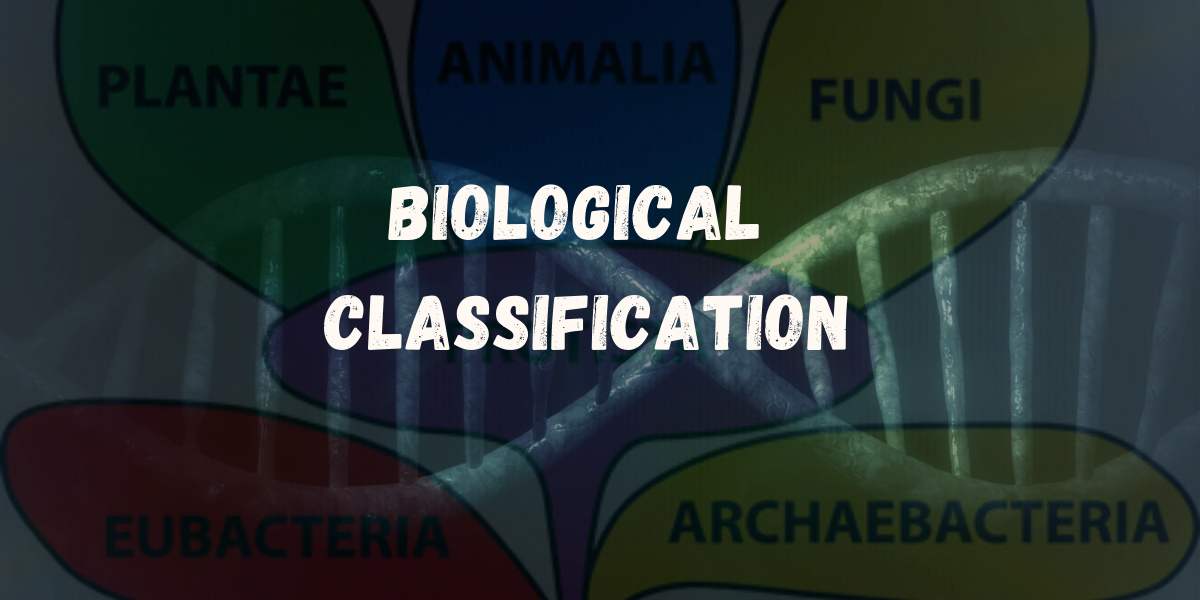
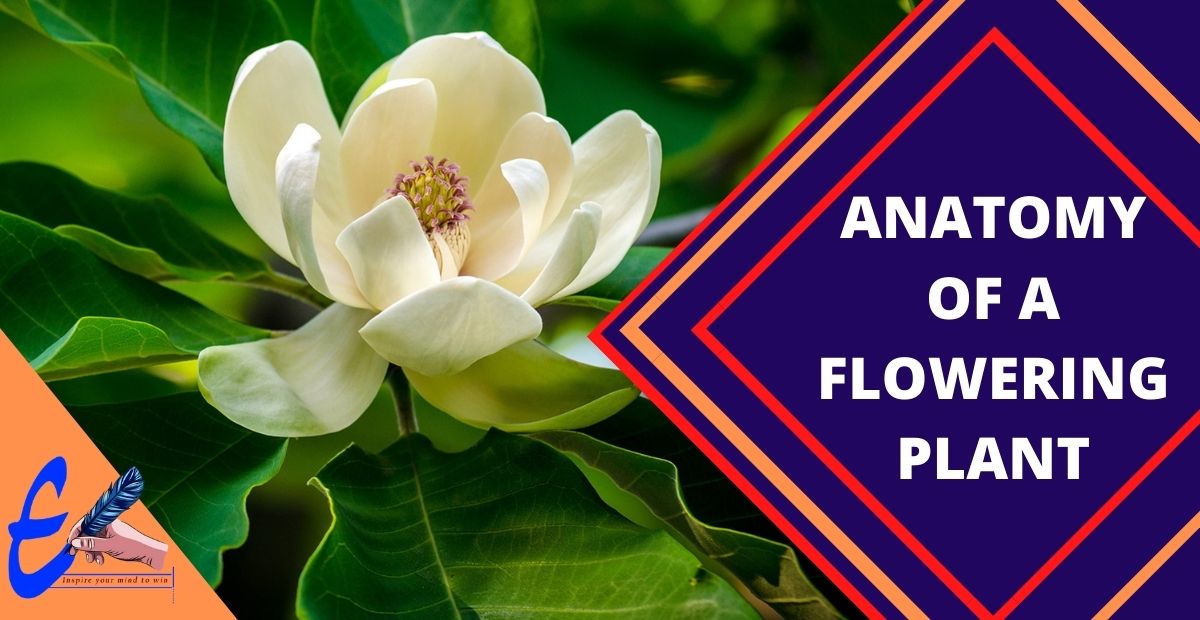
Informative….
… [Trackback]
[…] Info on that Topic: eklabhyaclasses.com/blog/biological-classification/ […]
… [Trackback]
[…] Read More here on that Topic: eklabhyaclasses.com/blog/biological-classification/ […]
… [Trackback]
[…] Here you can find 24162 more Information on that Topic: eklabhyaclasses.com/blog/biological-classification/ […]